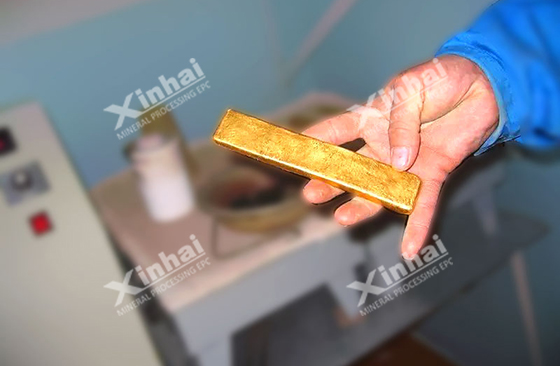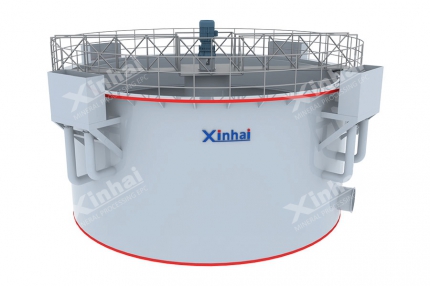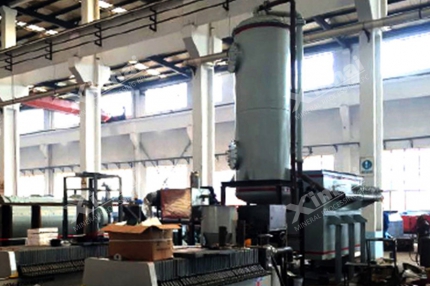Extraction of gold by cyanidation means to add the activated carbon in the cyanide pulp, the dissolved gold is adsorbed on the activated carbon, and the gold is extracted from the activated carbon. Generally, extraction of gold by cyanidation mainly includes raw material preparation, agitation and leaching, countercurrent carbon adsorption, gold loaded carbon desorption, electrolytic deposition, melting and tableting, carbon regeneration. Extraction of gold by cyanidation is suitable for flotation gold concentrate or amalgamation, gravity separation tailings, argillaceous oxide ore and high-graded large gold deposit and the gold ore associated with high-content silver and copper.
The extraction of gold by cyanidation mainly includes CIP and CIL processes, which are similar but different. Let's see the differences between the CIP process and the CIL process.
Use the table of contents below to navigate through the guide:
01Gold CIP process
The typical CIP process consists of cyanide leaching, activated carbon adsorption, desorption, and carbon regeneration.
The new (or regenerative) activated carbon is added in the last adsorption tank, the movement direction of the carbon is contrary to the flow direction of slurry, and finally, the gold loaded carbon is absorbed from the first adsorption tank, hence the term "countercurrent adsorption of carbon". The grade of gold in the solution from front to back of the carbon adsorption tank is gradually decreased, and the grade of gold-loaded carbon from the back of the adsorption tank is gradually increased, and finally, it is absorbed from the first tank. In the countercurrent adsorption of carbon, the desorption carbon or new carbon after pickling and thermal regeneration have the strongest activity and the fastest adsorption rate, which can reduce the gold grade of the final tail liquid to the minimum, reduce the losing chance of the dissolved gold from the tail liquid and improve the adsorption rate.

02Gold CIL process
The CIL process is developed based on the CIP process. CIL process reduces the number of leaching tanks and shortens the process flow, thus reducing the infrastructure investment and production costs. The leaching while adsorption improves the dissolution kinetics of gold, which is beneficial to gold leaching and adsorption. Because the CIL process has more obvious advantages than the CIP process, it is widely used in the gold processing plant all over the world.

03Gold CIP VS CIL Process
There are many significant differences between the CIP process and CIL process in terms of the process length, the amount of carbon stored in the process, carbon concentration, the volume of the adsorption tank, the amount of slurry needed to be transported for the char series, and the amount of metal accumulated in the process.
Table CIP process VS CIL process in parameters (Based on the 2000t/d gold processing plant)
| Process | Slurry feeding rate(m3·h-1) | Leaching series | Volume of single leaching tank | Adsorption series | Volume of single adsorption tank(m3) | Deposit amount of carbon(t) |
| CIP | 188.5 | 9 | 698.4 | 7 | 127.4 | 17.84 |
| CIL | 188.5 | 2 | 698.4 | 7 | 698.4 | 24.14 |
| Process | Carbon string speed(kg·h-1) | The amount of slurry to be transported(m3·h-1) | The amount of metal in the process-In the remaining carbon(kg) | The amount of metal in the process-In the solution(kg) | The amount of metal in the process-In the ore(kg) | The amount of metal in the process-The total amount of backlog(kg) |
| CIP | 136.37 | 6.8 | 32.24 | 34.75 | 2.04 | 69.03 |
| CIL | 136.37 | 27.62 | 42.9 | 8.4 | 2.04 | 53.34 |
From the above table, we can see that the CIP process is longer than the CIL process, but the CIL process contains more carbon and lower carbon concentration, and the amount of slurry to be transported for the carbon string of the CIL process is four times that of CIP process. And the CIP process has a large number of metal backlogs, and the distribution of the backlogs is different between the CIP process and the CIL process. The distribution of metals in the CIP process is roughly the same as in a solution, but under the CIL process, the metals are mostly stored in activated carbon.

Besides, the gold content of the solution in these two kinds of gold extraction process is also different. The solution of the CIL process has a higher gold grade than that of the CIP process because of the process structure. The CIL is leaching while adsorption, that means the dissolved gold is constantly fed into the solution, so the gold in the solution is constantly replenished, the gold content of the solution is relatively high. The CIP process is single adsorption, the amount of dissolved gold in the solution is very small, so the grade of gold is low.
Table CIP process VS CIL process in the gold content of the solution
| Adsorption level | 1 | 2 | 3 | 4 | 5 | 6 | 7 |
| CIP | 3.11 | 1.19 | 0.46 | 0.18 | 0.07 | 0.03 | 0.01 |
| CIL | 2.48 | 0.88 | 0.32 | 0.13 | 0.05 | 0.02 | 0.01 |
In short, the carbon in pulp (CIP) process means cyanidation leaching first and then adding the activated carbon in the slurry to adsorb gold. The carbon in leach (CIL) process means that the activated carbon is added to the leaching tank, the leaching and adsorption are carried out at the same time. In the CIP process, leaching and adsorption are independent operations. In the adsorption operation, the leaching process has been basically completed, and the size, number, and working conditions of the adsorption tank are determined by the adsorption parameters. In the CIL process, the leaching and adsorption operations are carried out simultaneously. Generally, the leaching operation takes a longer time than the adsorption operation, so the size, inflation, and dosing of the tank are determined by the leaching parameters.


 marketing@ytxinhai.com
marketing@ytxinhai.com  0086 13810327080
0086 13810327080 






































































































 CHAT
CHAT MESSAGE
MESSAGE





